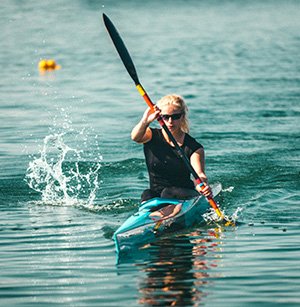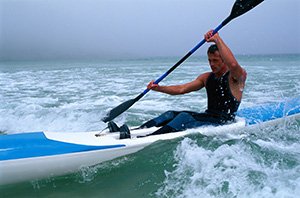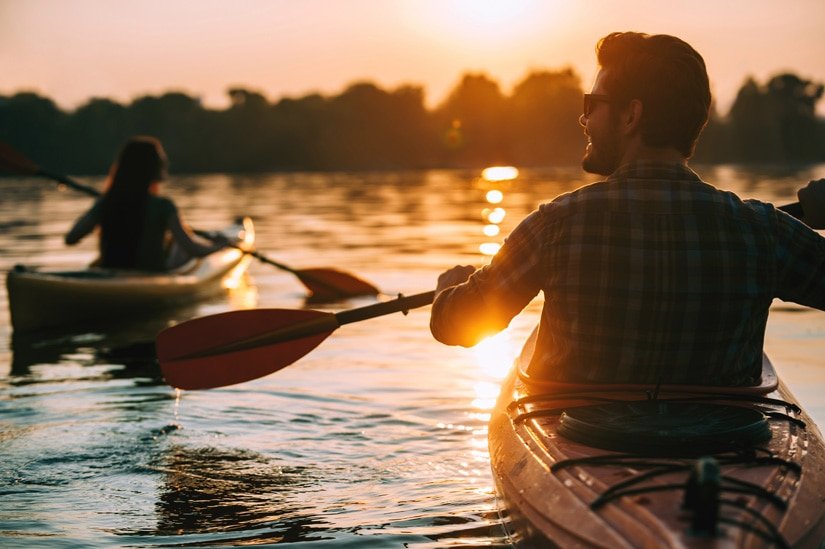What could you possibly gain from sitting in your kayak and paddling around?
Kayaking has been around for thousands of years. It was and is still used for different activities such as hunting and exploring. Rarely is it thought of as a form of exercise. How often have you heard someone say they are going to work out on their kayak?
Not only does kayaking work your muscles, but it also burns a significant number of calories (…) your mental health will improve.
Nonetheless, there are tons of benefits associated with this simple water sport. If you make it a routine, a few things in your life will change for the better. Not only does kayaking work your muscles, but it also burns a significant number of calories. Other than that, kayaking is a great way to clear your mind. Your mental wellbeing will improve.
Check out these little known health benefits of kayaking.
Key Takeaways
- Kayaking is a low-impact activity that burns many calories, works different muscles, and improves cardiovascular health.
- It can also boost mental well-being by exposing you to nature and sunlight and facilitating the production of feel-good hormones.
- Kayaking is a fun and non-traditional way to exercise and lose weight effectively.
- It, however, requires proper paddling technique and posture to avoid injuries and maximize the benefits.
- Kayaking is suitable for anyone who wants to be happier, healthier, and more fit.
a. Kayaking Helps You Lose Weight

For you to lose weight, you need to find an activity that burns calories efficiently. The more calories it burns in an hour, the better. Sometimes you can barely squeeze in time for exercise. Kayaking is one of those activities that help you lose weight by burn many calories in a short time.
According to this ACE calculator, a person weighing 100 pounds will burn 226 calories when kayaking for one hour. The number of calories burned kayaking is directly proportional to your weight. Heavy people will burn more.
See how other common activities compare (one hour for a 100-pound person):
- Running/jogging: 317 calories
- Walking (moderate pace, 3 mph): 149 calories
- Cycling (5.5 mph): 189 calories
- Swimming: 317 calories
- Weight training (normal): 136 calories
Kayaking is only second to running and swimming. Bear in mind that kayaking is a low impact activity and running is a weight-bearing exercise.
You are better off kayaking than weight training or walking if you want to get in shape.
Jennie lost a whole 240 pounds through kayaking. Healthy eating and staying active helped too.
These numbers are not just theoretical. People have used kayaking for weight loss and it works.
Jennie says she lost a whole 240 pounds through kayaking. Healthy eating and staying active helped too. What started as a casual activity became something she was committed to. Now, her goal is to help other people do the same.
You may also like: What size kayak do I need?
b. Kayaking Improves Your Mental Health

Who doesn’t want to be happy and at peace? Being in a good place mentally is something that everyone wishes to have. As more people speak out on mental health, countless solutions are being suggested.
There are many things that make kayaking a good activity for your mental health. The first one is that it is done outside. Being outdoors, surrounded by nature has shown to improve people’s well being.
According to this study, green exercise (one done in nature) has positive health benefits. Being in a green environment improves your mood and self-esteem. These two are associated with mental wellbeing. When water is present, the effects are greater.
This other study sought to see whether there is any relationship between depressive symptoms and vitamin D levels. More research is still underway. So far, however, there is evidence suggesting that high vitamin D levels can reduce depressive symptoms.
The two studies show that if you go kayaking, you mental health is likely to improve. You don’t even have to paddle— being outside is enough.
Also read: How to paddle a kayak.
Besides that, kayaking boosts the production of feel-good chemicals. They include serotonin, norepinephrine, dopamine and endorphins. These hormones give you some kind of high and regulate your mood. Endorphins in particular reduce stress levels and act as pain relievers.
Serotonin levels increase of you exercise regularly. High serotonin levels will translate into a sense of well-being. The chemical is also known to make you sleep better and boost your appetite. Both sleep and appetite are negatively affected by depression.
In addition to boosting the production of these hormones, kayaking balances stress hormones. It regulates the level of adrenaline in your body. This is not necessary a bad hormone but too much of it increases stress. Cortisol is another stress hormone that can go wild. Exercise keeps it at a healthy level.
c. Kayaking Gives You a Full Body Workout

To improve your physical health, everyone needs to be physically active for at least 30 minutes a day. The exercise should raise your heart rate and put all your muscles to use.
Although you paddle while seated in a kayak, you would be surprised to know the muscles that you use.
1. Hips and Legs
This is a surprise. How do you even use your legs while seated? The legs and hips play a vital role in kayaking. The contact that they make with the kayak helps you paddle. While you may not notice it, these two contact points (the legs and hips) are useful in the every movement.
2. Core
Your core muscles are used to a great extent in kayaking. You paddle from side to side. This requires a lot of turning. Since you are seated, your core is the main rotation point.
Your ab muscles are also responsible for your posture. The kayak is not a very wide vessel and you need to maintain the right posture for balance. The environment is not stable too so your body has to make an effort to remain balanced.
Lastly, your core generates most of the power used in the paddling motion.
3. Chest
If you have always wanted to have picture-perfect pectoral muscles, you should use your kayak more. In a kayaking paddle stroke, the arms work in opposite directions. While holding a paddle, one hand (the one on the lower side of the shaft), pulls the paddle back through the water. The other arm (on the upper side of the shaft) performs a pushing movement. The effect is the same as when you are doing a dumbbell bench press.
4. Arm Muscles
All the arm muscles, from the upper arm down to the finger muscles are used here. You will be using your finger and forearm muscles 100% of the time. During paddling, you will stretch, twist and flex your fingers and wrists and improve your muscle strength. Initially, this will be challenging.
As pointed out above, one hand pulls as the other one pushes. This engages your triceps and biceps especially during the first few strokes. It takes a moment for the rest of the body to become engaged.
5. Shoulder and Back Muscles
You may not realize that your shoulder muscles are being used until the next day. If you have not exercised in a long time, the soreness will tell. Every time you extend your arm, the shoulder muscles have to engage and help with that movement.
The lower back, like the core, is involved in maintaining the right posture. The upper back facilitates all the movement made by the upper body. While still on the back, make sure you are doing everything the right way. Learn the proper paddling technique; otherwise, you will hurt your back.
d. Kayaking Improves Your Cardiovascular Health

A good cardio workout lowers your resting heart rate and blood pressure. It also promotes “good” cholesterol levels and your cardiovascular health.
For a while, people have relied on conventional forms of exercise to get these health benefits and improve their aerobic fitness. They opt for the gym, running and other traditional activities. While these are great, they are not the only ones. You can get the same health benefits with a fun and “non-traditional” activity such as kayaking.
Contrary to popular belief, you don’t have to get into competitive kayaking. Recreational kayaking has proven to have amazing physiological effects. In fact, you can make it your daily exercise.
How does kayaking affect your cardiovascular health?
Kayaking is a low impact activity. It is not exactly intense but it causes your body to consume more oxygen.
Also read: How to get in and out of a kayak.
As your heart uses up more oxygen, its capacity increases. Consequently, heart chambers become bigger. Your heart is then able to pump blood to the rest of the body more efficiently without having to work too hard. You will notice that your resting heart rate becomes slower. Furthermore, you will find it easier to perform other physical activities such as walking and cycling for a longer period of time. You build your endurance.
Kayaking will reduce your risk of getting diseases associated with the heart. The activity keeps you active and fit. You will be less likely to get coronary heart disease and other heart issues. If there is a chance of you getting the disease, it will be much later in life and it will not be severe. See study.
Conclusion
So, how good is kayaking as a physical exercise?
Given the above health benefits of kayaking, it’s an outstanding physical exercise.
You can use it to lose weight and get into shape. The calculator above helps you estimate how many calories you will burn in an hour. Get on a healthy diet and mix kayaking with other simple exercises.
Taking out your kayak regularly is a great way to work all the muscles in your body—from your neck and upper body to your toes. It will also improve your heart health and prevent the development of cardiovascular diseases.
Another reason that should motivate you are the health benefits to your mental wellbeing. Try kayaking and you could become a happier, healthier version of yourself.

